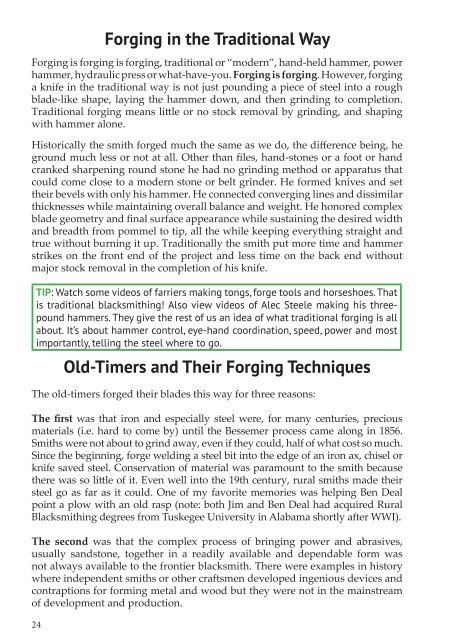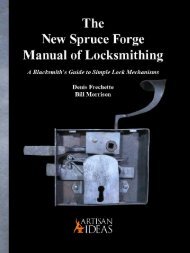FORGED: Making a Knife with Traditional Blacksmith Skills
This book will teach you to hand build a knife using the traditional method of blacksmiths of old — FORGING. Traditional forging of a knife blade is a process which uses the ancient techniques of moving hot steel with hammer and anvil alone into a knife-form that is ready for filing, heat treating and sharpening with no or very minimal electric grinding. This book also teaches traditional fit-and-finish skills using only hand tools. It explains an ancient riveted full-tang handle construction system that surpasses modern methods. In the author's words; "In my early blacksmithing years, I was lucky to get to know some old smiths who wrangled hot iron every day just to make a living. They unselfishly taught me traditional blacksmithing skills and knife forging methods. Every time I use those skills and methods, I honor their friendships, and by teaching you, the reader, we keep alive the memory of those old-time iron pounders." Hardcover, 132 pages, 150 photos and illustrations, $29.95.
This book will teach you to hand build a knife using the traditional method of blacksmiths of old — FORGING.
Traditional forging of a knife blade is a process which uses the ancient techniques of moving hot steel with hammer and anvil alone into a knife-form that is ready for filing, heat treating and sharpening with no or very minimal electric grinding.
This book also teaches traditional fit-and-finish skills using only hand tools. It explains an ancient riveted full-tang handle construction system that surpasses modern methods.
In the author's words; "In my early blacksmithing years, I was lucky to get to know some old smiths who wrangled hot iron every day just to make a living. They unselfishly taught me traditional blacksmithing skills and knife forging methods. Every time I use those skills and methods, I honor their friendships, and by teaching you, the reader, we keep alive the memory of those old-time iron pounders."
Hardcover, 132 pages, 150 photos and illustrations, $29.95.
Create successful ePaper yourself
Turn your PDF publications into a flip-book with our unique Google optimized e-Paper software.
24<br />
Forging in the <strong>Traditional</strong> Way<br />
Forging is forging is forging, traditional or “modern”, hand-held hammer, power<br />
hammer, hydraulic press or what-have-you. Forging is forging. However, forging<br />
a knife in the traditional way is not just pounding a piece of steel into a rough<br />
blade-like shape, laying the hammer down, and then grinding to completion.<br />
<strong>Traditional</strong> forging means little or no stock removal by grinding, and shaping<br />
<strong>with</strong> hammer alone.<br />
Historically the smith forged much the same as we do, the difference being, he<br />
ground much less or not at all. Other than files, hand-stones or a foot or hand<br />
cranked sharpening round stone he had no grinding method or apparatus that<br />
could come close to a modern stone or belt grinder. He formed knives and set<br />
their bevels <strong>with</strong> only his hammer. He connected converging lines and dissimilar<br />
thicknesses while maintaining overall balance and weight. He honored complex<br />
blade geometry and final surface appearance while sustaining the desired width<br />
and breadth from pommel to tip, all the while keeping everything straight and<br />
true <strong>with</strong>out burning it up. <strong>Traditional</strong>ly the smith put more time and hammer<br />
strikes on the front end of the project and less time on the back end <strong>with</strong>out<br />
major stock removal in the completion of his knife.<br />
TIP: Watch some videos of farriers making tongs, forge tools and horseshoes. That<br />
is traditional blacksmithing! Also view videos of Alec Steele making his threepound<br />
hammers. They give the rest of us an idea of what traditional forging is all<br />
about. It’s about hammer control, eye-hand coordination, speed, power and most<br />
importantly, telling the steel where to go.<br />
Old-Timers and Their Forging Techniques<br />
The old-timers forged their blades this way for three reasons:<br />
The first was that iron and especially steel were, for many centuries, precious<br />
materials (i.e. hard to come by) until the Bessemer process came along in 1856.<br />
Smiths were not about to grind away, even if they could, half of what cost so much.<br />
Since the beginning, forge welding a steel bit into the edge of an iron ax, chisel or<br />
knife saved steel. Conservation of material was paramount to the smith because<br />
there was so little of it. Even well into the 19th century, rural smiths made their<br />
steel go as far as it could. One of my favorite memories was helping Ben Deal<br />
point a plow <strong>with</strong> an old rasp (note: both Jim and Ben Deal had acquired Rural<br />
<strong>Blacksmith</strong>ing degrees from Tuskegee University in Alabama shortly after WWI).<br />
The second was that the complex process of bringing power and abrasives,<br />
usually sandstone, together in a readily available and dependable form was<br />
not always available to the frontier blacksmith. There were examples in history<br />
where independent smiths or other craftsmen developed ingenious devices and<br />
contraptions for forming metal and wood but they were not in the mainstream<br />
of development and production.










